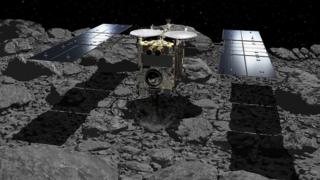News Updates
Japanese spacecraft bombs asteroid
http://www.bbc.co.uk/news/science-environment-47818460

 Image copyright
Image copyright
Akihiro Ikeshita
Artwork: Scientists want to retrieve a pristine sample of material from the crater
The Japanese Hayabusa-2 spacecraft is thought to have detonated an explosive charge on the asteroid it is exploring.
The idea was to create an artificial crater on the object known as Ryugu.
If this is successful – and the early indications are positive – the probe will later return to gather samples from the gouged depression.
Scientists believe these samples could help them better understand how Earth and the other planets were formed in the early Solar System.
Image copyright
JAXA
An apparent spray of debris is captured by the deployed camera
The explosive device, called the Small Carry-on Impactor (SCI), was released from Hayabusa-2 on Friday. The SCI, a 14kg conical container, was packed with plastic explosive intended to punch a 10m-wide hole in the asteroid.
Because of the debris that would have been thrown up in this event, Hayabusa-2 manoeuvred itself before the detonation to the far side of 800m-wide Ryugu – out of harm’s way and out of sight.
But the probe left a small camera behind called DCAM3 to observe the explosion. Images returned to Earth later on Friday appeared to show a spray of debris emerging from the limb of the asteroid, indicating the experiment to excavate a crater very probably worked.
Hayabusa-2 will, in a few weeks, return to the crater to try to collect its pristine samples. Because they will come from within the asteroid, they will not have been exposed to the harsh environment of space.
Bombardment with cosmic radiation over the aeons is thought to alter the surfaces of these planetary building blocks. So, scientists want to get at a fresh sample that hasn’t been changed by this process.
Ryugu belongs to a particularly primitive type of space rock known as a C-type asteroid. It’s a relic left over from the early days of our Solar System, and therefore records the conditions and chemistry of that time – some 4.5 billion years ago.

Real Life. Real News. Real Voices
Help us tell more of the stories that matter
Become a founding member
A video of the SCI being tested on Earth can be seen below:
Speaking at last month’s 50th Lunar and Planetary Science Conference (LPSC), project scientist Sei-ichiro Watanabe said the experiment would also “provide us with information of the strength of the surface layer of Ryugu”.
This could help shed light on how the asteroid developed its characteristic “spinning top” shape.
Image copyright
JAXA, Uni Tokyo & collaborators
Ryugu has a characteristic “spinning top” shape
Scientific results suggest Ryugu was formed from loose debris that was blasted off a bigger asteroid and then came back together to form a secondary object.
At the LPSC meeting, held in The Woodlands in Texas, Yuichi Tsuda, the mission’s project manager, told me how the team decided where on Ryugu to generate the artificial crater.
“There are two things: the first priority is to make a hole where we can easily identify a crater… so, easy observation, not too hard, not too bumpy,” he said.
“Second, somewhere that’s as feasible as possible in terms of landing… if those two don’t meet together, we go with the first priority.”
Scientists may command Hayabusa-2 to descend into the crater at a later date to collect a pristine sample of rock. But they will only do so if there is no risk of the spacecraft colliding with a boulder.
Follow Paul on Twitter.

Subscribe to the newsletter news
We hate SPAM and promise to keep your email address safe

